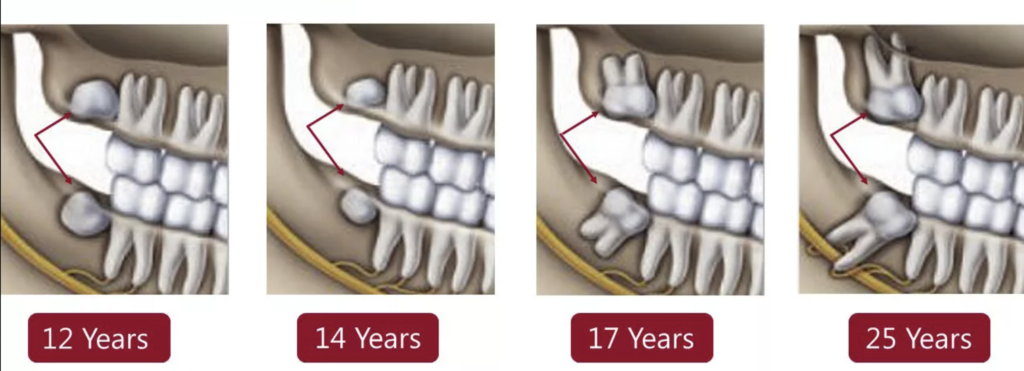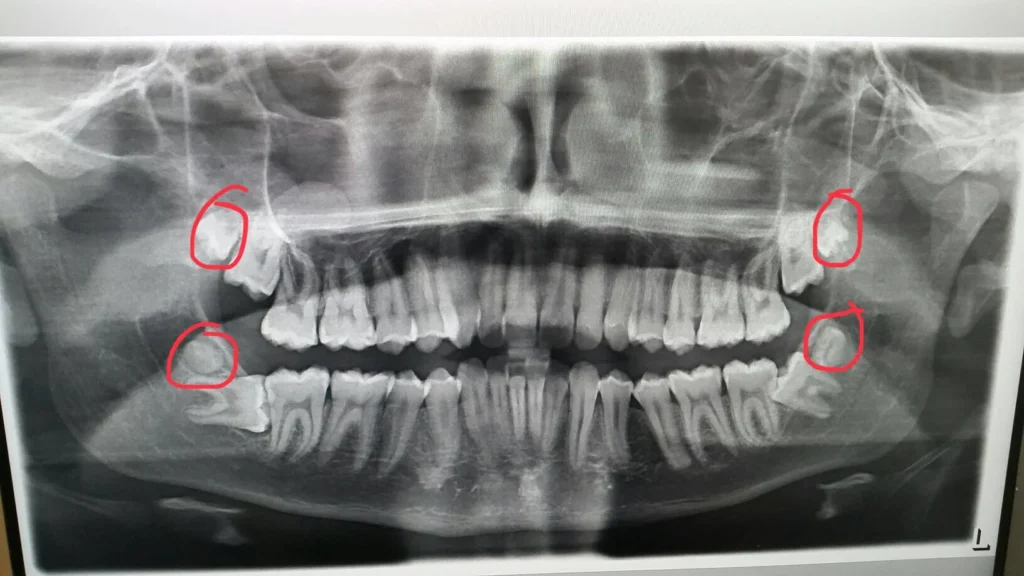We’ve all heard the tales of wisdom teeth coming in and causing all sorts of dental problems, from overcrowding to impaction. Some of you may have experienced the sharp pain that comes with impaction, while others have never suffered from it. But one question that often floats around is, “When do these notorious third molars actually show up?”
In general, most wisdom teeth erupt between the ages of 15 and 25. This is the age range when the wisdom teeth will grow out of the gumline and become visible.However, some people may experience earlier or later emergence. But can a wisdom teeth come in earlier or later than the aforementioned age range?
In the rest of this article, we will breakdown the tell-tale signs of an emerging wisdom teeth, as well as whether there are external factors that can affect the appearance of these late bloomers.
So stick around as we demystify the timing and developmental stages of wisdom teeth, and help you understand what to look out for. Ready to get wise about wisdom teeth? Let’s dive in!
How Do Wisdom Teeth Grow and Erupt?
The wisdom teeth, which are the third and last set of molars to set in, are a subject of curiosity to many due to how late it erupts. But do you know that they growth takes place early on during childhood?
The buds of the wisdom teeth start form in as early as 8 to 10 years old but remain dormant for many years. During this period, they remain invisible to the naked eye and standard radiographic imaging.
In your teen years, these tooth buds start to mature, and the crown (the part of the tooth above the gumline) begins to form. This is the time when the tooth becomes visible in a dental X-ray. Over time, as the crown forms and the roots grow, the wisdom tooth begins to push against the surround bone and tissue. In most cases, you will experience some form of pain or pressure at the back of the mouth.

During your early adulthood, usually between the ages of 17 and 25, the teeth begins to break through the gum, becoming visible in the mouth. The level of visibility can vary from person to person, sometimes showing fully and sometimes remaining partially. If you feel pain and the wisdom tooth can’t be seen, it is likely that the tooth is fully impacted. This often leads to a host of problems like infection and damage to the adjacent teeth as it is being pushed.
As seen, a wisdom tooth starts forming during your childhood but erupts only during your adulthood. So the next time you feel something happening at the back of your mouth, you’ll have a good idea of what’s going on, won’t you?
Why Do Wisdom Teeth Come in So Late?
Why do wisdom teeth make you wait so long before they decide to erupt? This question has baffled both you and I, as well as researchers. The most common theory suggest that it is part of our evolution.
Back in the days, our ancestors were on a tough diet consisting of raw roots, uncooked meat, and hard nuts. These would wear down their teeth rather quickly, making tooth loss a common occurrence. It was surmised that the wisdom tooth came in at a later age to supplement the tooth loss by ‘offering’ a new set of teeth.
In essence, wisdom teeth could be the mouth’s equivalent of a late-game player in sports. They would show up just in time to replace other worn-out or lost teeth, ensuring that our forebearers could continue to chew their hard diets effectively.
Fast forward a few millennia, most of us are now on a soft diet consist of processed food that are easier to chew. This has allowed us to keep our teeth longer. As a result, when our wisdom teeth erupt, they often find themselves competing for space with the existing teeth.
There are several other factors that researchers believe are the factors at play when it comes to the late bloomers.
- Genetics: If your parents’ wisdom teeth came in late or not at all, the same might happen for you
- Nutrition: Nutrition and overall health can also impact how and when your wisdom teeth come in
- Others: Even factors like stress and illness during childhood and adolescence might contribute to the timing of these late bloomers.

Interestingly enough, wisdom teeth are highly unpredictable. Some people never develop them, while others might have more than the typical four—yes, you heard that right! There are numerous cases of individuals with up to 8 wisdom teeth. These additional teeth are known as supernumerary teeth and they appear in addition to the regular set of teeth we have.
You may be interested in: Removing Your Wisdom Teeth After 30? Here’s What You Need to Know
Can Wisdom Teeth Come In at 30?
While 15 and 25 is the age range where the wisdom teeth comes in, can it happen when you are 30 years old?
The answer is yes! It is not uncommon for these late bloomers to appear in your late 20s or even your 30s. As unpredictable as they are, these teeth don’t always adhere to a specific timetable.
In a growing number of cases, the wisdom teeth remain impacted (stuck under the gumline) for years well beyond the standard age range. This can be due to a lot of factors ranging from genetics to the availability of space in your jaw.
So what should you do if you suddenly feel a pain in the back of your mouth that you have never felt before in your 20s? The first step is to schedule an appointment with your dentist for an evaluation. Depending on your dental health and the position of the erupting teeth, you may need to get them removed to avoid potential dental problems.
Can Wisdom Teeth Come In at 40?
If your wisdom teeth did not erupt in your 30s, does it mean you are safe? Could it be? A wisdom tooth at 40? While it’s less common, the answer is yes, wisdom teeth can come in at 40 or even later.
Once again, the late appearance can be attributed to several factors like genetics, stress, environment, and diet. However, the eruption of the wisdom teeth beyond 40 years old is uncommon and not entirely understood by the dental community.
You may be interested in: Is It Possible to Have 8 Wisdom Teeth and Why?
If you do find a new molar making its entrance at 40, don’t just brush it off. Schedule a visit to your dentist for an evaluation. With age, the risk associated with wisdom teeth, like impaction or an extraction, can make things much more complicated. For instance, your recovery from a wisdom teeth removal surgery will be longer as your body requires more time to heal as compared to someone in their late teens and early 20s.
That said, with advancements in technology, having a wisdom teeth at 40 is much more manageable than you might think.
Closing Thoughts
To conclude, most people can expect these notorious third molars to come in between the ages of 17 and 25. Some folks may never see their wisdom teeth, while others might get a surprise in their 30s or even their 40s. A myriad of factors, including genetics, jaw space, and overall health, contribute to this dental mystery, making it hard to pin down an exact timeline for everyone.
Whether you’re a teenager anxiously waiting for your wisdom teeth or an adult shocked by their late arrival, remember: you’re not alone. The important thing is to stay informed and keep up with your dental check-ups. After all, wisdom comes in many forms, and sometimes it even comes in the form of teeth!





